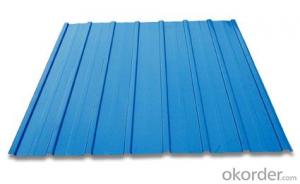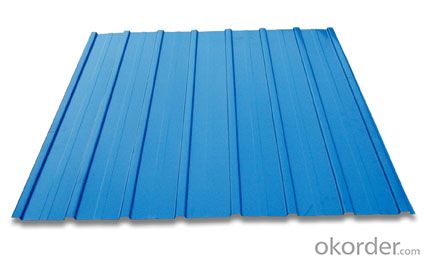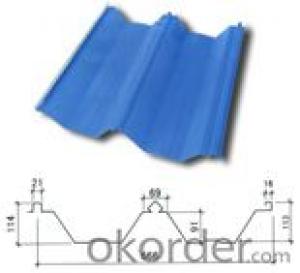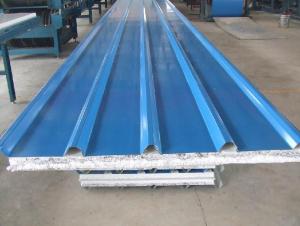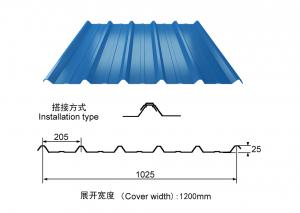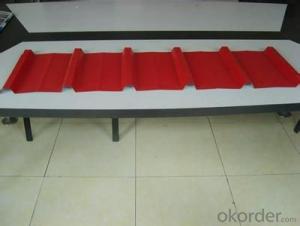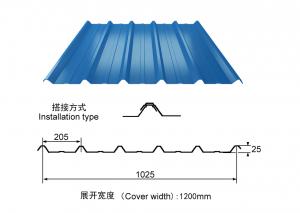corrugated colored steel sheets
- Loading Port:
- China Main Port
- Payment Terms:
- TT OR LC
- Min Order Qty:
- -
- Supply Capability:
- -
OKorder Service Pledge
OKorder Financial Service
You Might Also Like
Quick Details
| Standard: | Grade: | Thickness: | |||
| Place of Origin: | Brand Name: | Model Number: | |||
| Type: | Technique: | Surface Treatment: | |||
| Application: | Special Use: | Width: | |||
| Length: | Surface Treatment:: | Type:: | |||
| Material: | Color: |
Packaging & Delivery
| Packaging Detail: | According to international export standard or as your request |
| Delivery Detail: | with in 15 days after deposit |
Specifications
color corrugated roofing sheet
1)Model:828,840,V-900,V-910
2)Color:all RAL NO.
3) Thickness:0.2-0.6mm
corrugated colored steel sheets/prepainted metal roof/building materials is a new building materials made from high-quality color coated steel plate with automatic forming machine. It can substitute asbestos tile, glass steel tile and common roof materials. It has many advantages which can satisfy the demands of present various building style, such as easy installation, short building period, bump resistance, fireproof, corruption resistance, beauty, light weight but high strength.
Features
Width: 460 760 750 820 840 900 850 880.900 910.914
Length: according to customers' requirements
Thickness: according to customers' requirements
features of Color Coated Steel :
1.it is suitable for various climates, easy to be maintained, good endurance.
2.it is light, easy to be installed and heat insulation.
3. it has the characteristics of Fireproof and resistance of wind
4.Many colors available, with elegant and noble looking. It is widely used in factories, hotels, exhibitions, villas and civil construction.
5. It can substitute the traditional clayey tile and cement tile and save much land resources.
6. It can be recycled and good for environments.
7.it is easy to be used and transported, then it can save human and materials resources during building.
Application:
commercial use, structural use, household appliance, light industry, constructure
wear resistant steel, high-strength steel plate
Specifications
| product | color corrugated roofing sheet |
| Brand | ZHUWEI |
| supply ability | 5000 meters per day |
| base material | galvanized steel sheet |
| thickness | 0.2-0.6mm |
| width | 600-1250mm |
| quality | spcc,dx51d,sgcc,sgch |
| zinc-coating | 60-275g/m2 |
| technique | cold rolled-hot dipped galvanizing- corrugated |
| Payment Terms | T/T L/C D/A D/P |
| tolerance | thickness: +/- 0.02mm |
| width: +/-2mm | |
| feature | sheet metal roofing have excellent performance of decoration, corrosion resisitance etc. |
| package | 1. PVC film 2. Anti-water paper. 3. Metal |
- Q: What are the different jointing methods for steel sheets?
- Steel sheets can be joined using various methods, depending on specific requirements and applications. Common jointing methods for steel sheets include welding, bolting, riveting, adhesive bonding, and mechanical fasteners. Welding is widely used, involving melting the steel sheet edges and joining them by applying heat and pressure. Different welding techniques, like arc welding, gas welding, or laser welding, can be used depending on the steel sheet thickness and type. Bolting involves using bolts and nuts to join steel sheets together. This method is suitable for easily disassembling or replacing joints and can be used for both permanent and temporary connections. Riveting is another method, using rivets to join steel sheets. Rivets are cylindrical metal pins inserted through holes in the sheets and deformed to secure the joint. Riveting is ideal for applications requiring high shear strength. Adhesive bonding uses specialized adhesives to join steel sheets. This method provides a strong and durable joint, suitable when welding or other mechanical jointing methods are not suitable. Adhesive bonding also distributes stress more uniformly across the joint. Mechanical fasteners, like clips, clamps, or brackets, can be used to join steel sheets. These fasteners offer a secure and reliable connection without requiring welding or other permanent jointing methods. They are commonly used when ease of assembly and disassembly is necessary. In conclusion, the choice of jointing method for steel sheets depends on factors such as the application, desired strength and durability, and ease of assembly and disassembly. Careful consideration of these factors is essential to ensure a successful and reliable connection.
- Q: Can steel sheets be used for insulation cladding?
- Typically, insulation cladding does not involve the use of steel sheets. Instead, materials like foam boards, mineral wool, or fiberglass are commonly chosen for their thermal insulation properties. These materials are effective in minimizing heat transfer and enhancing energy efficiency. Conversely, steel sheets are more frequently utilized for structural purposes or as a protective layer owing to their robustness and durability. Though steel sheets can offer some protection, they lack the requisite insulation properties required to effectively prevent the transfer of heat or cold. Consequently, it is advisable to employ suitable insulation materials specifically designed for cladding purposes.
- Q: What is the typical electrical conductivity of a steel sheet?
- The typical electrical conductivity of a steel sheet is relatively low compared to other metals, with a range of around 1 to 7 million siemens per meter (S/m).
- Q: What's the density of the 0.5 color steel plate?
- 0.5 color steel plate density is 7.85kg/m fand.Color refers to the color coated steel plate, color coated steel plate is a steel plate with organic coating, with good corrosion resistance, bright color, beautiful appearance, easy molding and has a steel plate and the original strength and low cost.
- Q: What is the standard size of steel sheets?
- The standard size of steel sheets can vary depending on the specific application and industry. However, a common standard size for steel sheets is typically around 4 feet by 8 feet.
- Q: How are steel sheets protected during storage in warehouse facilities?
- Steel sheets are protected during storage in warehouse facilities through various measures such as applying protective coatings, using moisture-resistant packaging, implementing proper stacking and handling techniques, and maintaining controlled temperature and humidity levels to prevent corrosion and damage.
- Q: What is the shelf life of steel sheets?
- Steel sheets are typically believed to have an indefinite shelf life. Unlike perishable items, steel sheets lack an expiration date or limited lifespan. If stored and maintained properly, steel sheets can maintain their good condition for numerous years, if not decades, without significant deterioration. However, exposure to certain environmental elements like moisture, extreme temperatures, and corrosive substances can impact the quality and durability of steel sheets over time. Hence, it is advisable to store steel sheets in a controlled and dry setting to guarantee their longevity and avert any potential harm or decline.
- Q: What are the different surface treatments available for steel sheets?
- There are several surface treatments available for steel sheets, including galvanizing, electroplating, powder coating, and painting.
- Q: Can steel sheets be used in agricultural applications?
- Yes, steel sheets can be used in agricultural applications. They are often used for building structures such as barns, sheds, and fences. Steel sheets provide durability, strength, and protection against weather conditions, making them suitable for various agricultural needs.
- Q: How to pass through steel at water stop steel plate?
- The steel bar cannot pass through the water stopping steel plate, and this should be taken into consideration when arranging the water stop steel plate.Therefore, the water stop steel plate is usually arranged at the end of the plate or wall, but can not be arranged at the edge of the beam column, otherwise the stirrup is interrupted.
Send your message to us
corrugated colored steel sheets
- Loading Port:
- China Main Port
- Payment Terms:
- TT OR LC
- Min Order Qty:
- -
- Supply Capability:
- -
OKorder Service Pledge
OKorder Financial Service
Similar products
Hot products
Hot Searches
Related keywords
